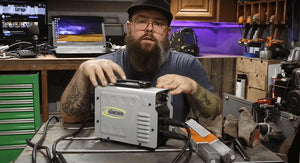8 products
The smallest 2-in-1 Stick Welder & Hot Stapler in the world
ARC-120M

ARC Series

ARC-200S
Stick / Lift TIG / VDR / 120Amp DC 110V/220V Dual Voltage

ARC-200 Mini
Stick / IGBT / Portable / 110V & 220V / 50-60Hz
MIG Series

MIG-250
Stick / MIG / MAG / TIG

MIG-140S
Stick / MIG
SD-4050 Series

Upgraded SD-4050Pro(2024)
Take your welding skill to the next level

SD-4050Pro
Powerful 10-in-1 Aluminum Welder&Cutter
Upgraded SD-4050Pro(2024)

Reviews

ARC-200S
Stick Welder, Stick Welding Machines and SMAW Welders
Stick welding, a popular and versatile joining technique, relies on a simple yet effective setup. The welder connects to an electrode holder, which acts as a conduit for electricity to the chosen electrode. This electrode is held securely within the holder.
To complete the electrical circuit, a ground clamp connects the welder directly to the workpiece. With everything in place, the welder strikes an arc between the tip of the electrode and the workpiece. The intense heat generated by this arc melts not only the workpiece material but also the electrode itself.
Here's where the magic happens: the electrode comes coated in a special flux. As the electrode melts, this flux releases a shielding gas that protects the molten metal from harmful airborne contaminants. This shielded environment ensures a clean and strong weld is formed by the fusion of the melted workpiece material and electrode material.
Stick welding, known for its simplicity and resilience, offers several advantages for various projects. Here's why it might be your perfect welding match:
Tames the Wind: Unlike MIG and TIG welding, the stick doesn't rely on shielding gas, making it ideal for outdoor environments where wind can disrupt the gas flow.
Pack and Go Portability: With fewer components compared to MIG and TIG setups, stick welding is a breeze to transport and set up, allowing you to tackle projects on the go.
Material Master: Stick welding demonstrates impressive versatility, tackling the most common metals and alloys. It can even handle dirty or rusty surfaces, saving you time on pre-cleaning in some situations.
Perfect for Short Stints: Since the electrode continuously feeds during use, stick welding excels at shorter welding jobs, eliminating the need for frequent spool changes.
Faqs
Frequently Asked Questions
What is a stick welder?
A stick welder, also known as, Shielded Metal Arc Welding (SMAW). This versatile workhorse utilizes a consumable electrode coated in flux to create strong welds. Popular in construction, fabrication, and repair, SMAW is a favorite for its simplicity and ability to handle various materials and environments. SMAW is a go-to choice for its simplicity, affordability, and ability to weld in various conditions.
What is a stick welder good for?
Stick welding is a popular choice due to its simplicity and adaptability. This versatile arc welding technique finds applications in a wide range of industries and projects. From shipbuilding and towering constructions to oil pipelines, structural beams, and the bustling world of manufacturing, stick welding remains a reliable workhorse for tasks like steel fabrication and even mining operations.
How does a stick welder work?
Stick welding utilizes an electric current to create a powerful spark – the arc. This arc jumps between a consumable electrode rod, coated in a special flux, and the metal you're welding (the workpiece). The intense heat melts both the electrode and the base metal, forming a molten pool that fuses them together. The flux coating, vaporized by the heat, releases protective gases that shield the weld pool from harmful air contamination, ensuring a clean and strong connection.
What materials can be welded with a stick welder?
Stick welding boasts impressive versatility, tackling a wide range of materials like carbon steel, stainless steel, cast iron, and even some non-ferrous metals.
Can a stick welder be used for structural welding?
Yes! From towering skyscrapers and sturdy bridges to intricate pipelines, it's the go-to method for joining steel in construction projects. But remember, safety first! Depending on the project and industry regulations, specific welding procedures and certifications might be mandatory.











